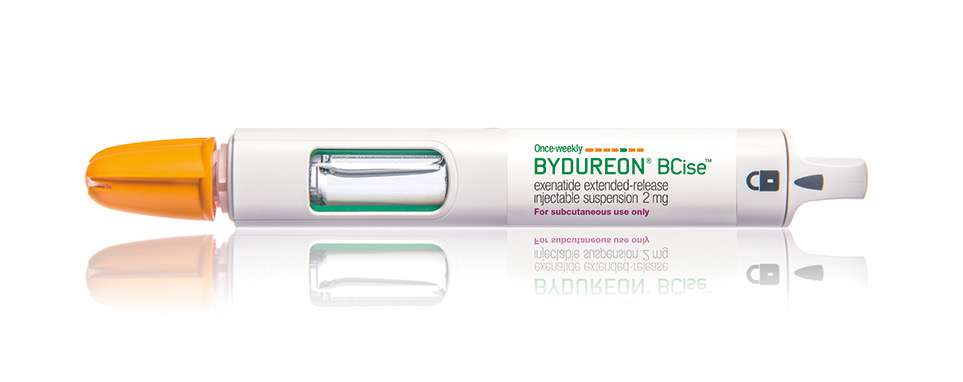FDA Approves Exenatide for Children and Teens with Type 2 Diabetes
By Andrew Briskin
 The FDA recently approved BYDUREON BCise (an extended-release version of the GLP-1 drug, exenatide) for teens with type 2 diabetes. Recently published data shows disturbingly high rates and serious diabetes complications in people who develop type 2 diabetes at a young age suggesting the need for aggressive early treatment and more treatment options.
The FDA recently approved BYDUREON BCise (an extended-release version of the GLP-1 drug, exenatide) for teens with type 2 diabetes. Recently published data shows disturbingly high rates and serious diabetes complications in people who develop type 2 diabetes at a young age suggesting the need for aggressive early treatment and more treatment options.
On July 23rd, the FDA approved the drug BYDUREON BCise (exenatide), a GLP-1 receptor agonist, for teens ages 10-17 with type 2 diabetes. This drug is a once-weekly injection that can help people manage their glucose levels coupled with changes in their lifestyle (diet and exercise).
The approval of BYDUREON BCise comes after encouraging results from a clinical trial called BCB114, which examined the safety of the drug in the age group between 10-17 years old. BYDUREON BCise has been approved in the US for adults with type 2 diabetes for over 15 years, and now, with the results from this clinical trial, BYDUREON BCise has been deemed safe for teens with type 2 diabetes as well. Results from the BCB114 trial showed a 0.4 percentage point decrease in A1C when using BYDUREON BCise compared to a 0.5 percentage point increase in A1C among those taking the placebo drug.
Given how limited the treatment options are for this population (only three other non-insulin medications are currently approved), the approval of an additional medication is exciting, especially given that this medication could also potentially have positive effects on weight management and heart health.
According to Dr. Lily Chao, a pediatric type 2 diabetes specialist and assistant professor of clinical pediatrics at the University of Southern California, “This approval represents the first once-weekly GLP-1 receptor agonist that will be available to youths with type 2 diabetes [other approved GLP-1 drugs Victoza and Saxenda are injected once-daily]. It adds to the options for patients who cannot attain glucose control on metformin alone. The safety profile of this medication seems to be very similar to that in adults and I’m excited that there is now another option for management of pediatric type 2 diabetes.”
Dr. Philip Zeitler, Section Head of Endocrinology and Medical Director at Children’s Hospital of Colorado Clinical and Translational Research Center, shared this optimism on the future of medications for pediatric type 2 diabetes. According to Dr. Zeitler, “exenatide was first in its class of GLP-1 receptor agonists, but was originally given by injection twice a day, which led to challenges of treatment adherence. The once-weekly version addresses that concern, and with many other medications in this class currently under study in kids, we may likely see them receive approval in the next few years.”
BYDUREON BCise is a type of drug called a glucagon-like peptide (or GLP-1) receptor agonist. GLP-1 receptor agonists work by supporting the action of a hormone called GLP-1 that stimulates the release of insulin in your body. Some GLP-1 receptor agonists have been shown to help with weight management in people with both diabetes and obesity and can also lower the risk of heart disease.
These effects have become increasingly important to address in the youth population with type 2 diabetes. Results from a recent clinical study called TODAY2 show a decrease in blood glucose control in youths with type 2 over the last 15 years. Additionally, the study emphasized the need for heart health benefits in this population, with over two thirds of study participants having high blood pressure and over half of the participants showing high fat levels in the blood and early warning signs of amputation.
As previously mentioned, the only non-insulin medications approved for teens with type 2 diabetes prior to BYDUREON BCise included metformin and Saxenda and Victoza (both GLP-1 receptor agonists). Compared to the wide variety of medications available for adults, only three have been approved in teens, despite the increasing prevalence of type 2 diabetes in this age group over the last 20 years along with alarming increases in childhood obesity across the United States. According to the SEARCH study, which tracks new cases of diabetes in youths younger than 20, new cases of type 2 diabetes have increased by an average of 4.8% per year since 2002, raising the number of youths under 20 with type 2 diabetes to over 200,000.
Given these trends and the alarming results of the TODAY2 study, it is now more important than ever that this population has multiple options for diabetes management.
“We have seen a concerning rise in the number of children who develop type 2 diabetes,” said Dr. Chao. “Diabetes-related complications develop earlier in people diagnosed in childhood compared to those diagnosed in adulthood. These complication rates are also higher when compared to children with similar duration of type 1 diabetes. Having more treatment options allows us to personalize treatment plans. As we know, one size does not fit all when it comes to medications.”
This is especially true because “patients may develop intolerable side effect to one medication but not another,” Said Dr. Chao. “Having options allows us to offer patients a choice that may better suit their needs”








